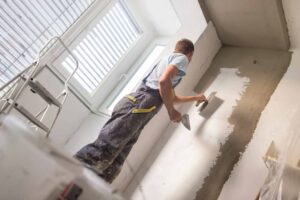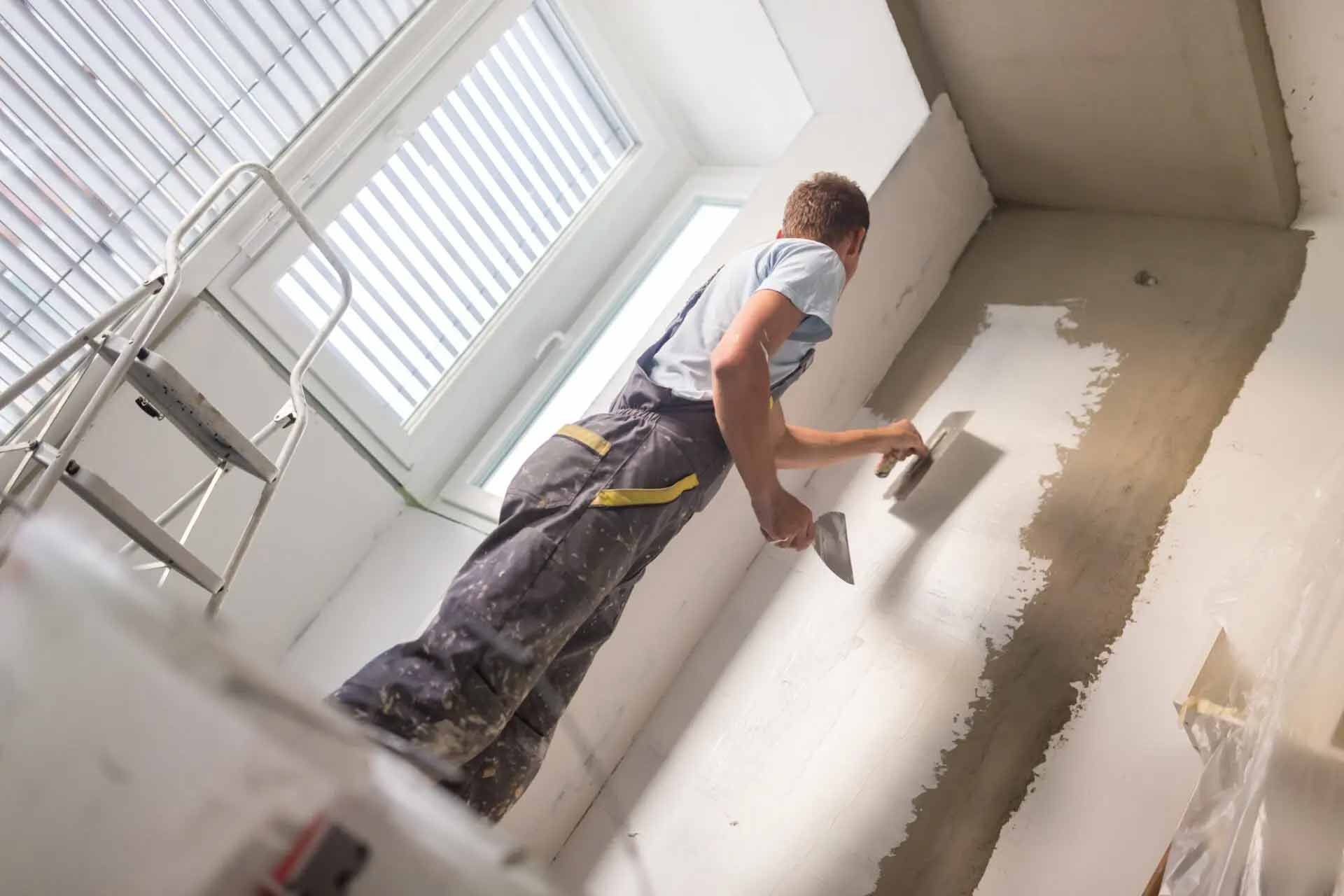Stucco Repair Philadelphia is something most homeowners with stucco houses will have to deal with at some point. It’s important to take care of it quickly to prevent further damage and keep costs down.
Small cracks less than 1/4 inch can be filled in with acrylic exterior caulk. For cracks wider than that, a professional will need to use a cold chisel and hammer to widen the crack and bevel it.
Stucco is a durable material capable of lasting 100 years or more when it’s properly installed and maintained. But it can be damaged by many different things. Moisture is one of the most common causes. If your stucco is not caulked correctly around windows and doors, moisture can build up behind the material and cause mold, wood rot, and buckling. In addition, impacts from woodpeckers or stray baseballs can leave small chips in the surface, and your home’s settling can cause cracking.
If you notice any of these signs, it’s time to call a professional. A professional can inspect your stucco and recommend the best course of action. They will check for underlying issues, such as water damage, and repair or replace the affected materials. They can also help you choose the right color to match your existing stucco.
The cost of repairing stucco depends on the severity and extent of the damage. Large cracks, for example, can be much more costly to fix than smaller ones. Additionally, if the cracks are in hard-to-reach places, it will increase the overall cost of the project.
It’s important to choose a reputable contractor to perform your stucco repair. Be sure to look for testimonials and reviews. You should also make sure that your contractor is licensed and insured. This will protect you from scams and ensure that the job is completed to your satisfaction.
In addition to the cost of materials, you should also consider other associated costs. These may include labor setup time, mobilization charges, and minimum hourly charges. You should also add in any cost of removing, modifying, or repairing existing framing, surfacing, and/or HVAC, plumbing, or electrical systems to bring them up to code. Finally, don’t forget to include any permit or inspection fees that you might need to pay.
If you’re thinking of tackling a DIY stucco project, be aware that it can be very time-consuming and complicated. Even if you’re very handy, it’s often easier to hire a professional to handle the work for you. Not only will this save you time, but it will also prevent costly mistakes that could cost you a lot of money down the road.
Materials
Stucco is a popular exterior finish for homes, but it requires regular maintenance. Moisture is one of the biggest culprits in plaster deterioration. It enters a building through cracks, around chimneys, and window and door openings. It can also get behind lath that is torn or not properly lapped at the seams.
When moisture is allowed to enter the home, it can lead to mildew and mold, ugly discoloration on the outside, and wall rot that can destroy the structural integrity of the walls. The most common way to manage moisture is by installing an air barrier, but even if you have done this, it can be difficult to know what to do when water leaks into your home’s plaster.
The best way to avoid water damage is to make sure that all cracks are closed with waterproof caulking. This is an easy DIY project that can save you money on repair costs. A standard caulking kit from Quikrete costs about $30 and includes everything you need to repair hairline cracks.
To start your stucco repair, remove any loose flakes of paint from the surface. Then, use the wire brush to clean the area around the crack. This will help the new stucco patch stick better. You should also vacuum up any dust that has accumulated in the cracks. Finally, spray the area with water to moisten the surface and prepare it for patching.
If you’re not comfortable doing the job yourself, you can hire a professional to handle it for you. It’s important to work with a contractor that has experience with stucco repairs and can offer you a warranty for their work.
Before starting the repair, it’s important to protect yourself by wearing a face mask and safety glasses. Using a hammer and cold chisel, widen the crack to at least a quarter inch and remove any loose pieces of stucco. It’s also a good idea to remove any damaged wire mesh lath that may be present.
Once the crack is widened, cut a piece of grade-D builder’s paper to fit the size of the repair area and secure it to the sheathing with roofing nails. Next, add a piece of fiberglass or galvanized metal lath and trim it to fit the opening with tin snips.
Safety
A stucco repair expert must be careful not to damage the surrounding area during this project. This can cause the cracks in your stucco to widen, which could result in even more damage. It is also important that the weather conditions be ideal for this project. Stucco can’t be worked on if it’s too cold or too hot, as this will affect how well the cement and water mix. This can lead to poor-quality repairs and may even make the problem worse.
A good way to assess the condition of your stucco is to look for cracks and chips. These signs indicate that the weather is starting to wear away at the surface, and it’s time for a stucco repair. You should also check for leaking areas and any moisture problems in the building’s sheathing, insulation, and framing. These are major issues that can lead to rot, mold growth, and structural problems.
Another sign that it’s time to call in a stucco repair professional is if your walls are showing signs of wildlife damage. Termites, squirrels, woodpeckers, and other creatures have been known to munch on stucco, leaving holes that can cost thousands of dollars in damages each year. This can be avoided if you spot any damage early and have it addressed as soon as possible.
Gaps around windows and doors are another sign that the stucco needs to be repaired. These gaps allow moisture to seep into the walls, which can lead to water damage and other problems. A stucco repair expert should be able to seal these gaps and prevent further moisture intrusion.
When repairing stucco, it’s important to use a high-quality material. This will ensure that the patch you install is long-lasting and durable. It’s also a good idea to buy a stucco repair mix that can be easily tinted. This will help you match the color of your existing stucco and give it a consistent appearance.
If you’re planning to do the staining and painting yourself, it’s best to choose a waterproof material. This will protect the underlying framing and sheathing from moisture damage and prevent mold and rot from growing. It will also make it easier for you to maintain your new stucco.
Time
Stucco repair can take a while because the process is more involved than simply patching a small crack or hole. A stucco professional may need to remove old plaster, apply a base coat, and then add the final coats of stucco. These steps can be very time-consuming and often require the use of special tools. The location of the damaged areas can also affect the amount of time that it takes to complete a stucco repair project. For example, if the damage is on the second or third story of a home, then the stucco professional will need to climb ladders and scaffolding to access the area. This can increase the cost of the project and add to the overall timeline.
In addition to the time needed to perform the actual repair work, it can also take a while for the plaster to dry. This is because the stucco must cure completely before it can be painted or otherwise finished. Typically, this process can take between 24 and 72 hours, depending on the weather conditions.
If a homeowner wants to speed up the drying process, they can spray the stucco with water or another liquid. However, this method is only recommended for minor cracks that are less than 1/16 of an inch in width. It should not be used to repair larger cracks or holes, which can cause structural problems for the home.
When stucco becomes chipped or crumbling, it should be inspected by a stucco repair professional immediately. This is because it could be a sign of water damage, foundation settling, or a pest infestation.
Moisture penetration through cracks in the stucco can lead to water damage, rot, and mold growth. Leaving the problem untreated can lead to expensive repairs and potential health issues for a homeowner.
A homeowner should look for signs of moisture penetration, including a musty or sour smell, soft spots, or indentations. The homeowner should also check the structure of the home for leaks or a foundation issue. There are surface scanners available that can be run over the stucco to determine moisture levels. However, these are not entirely accurate or definitive and should be used in conjunction with invasive testing.
